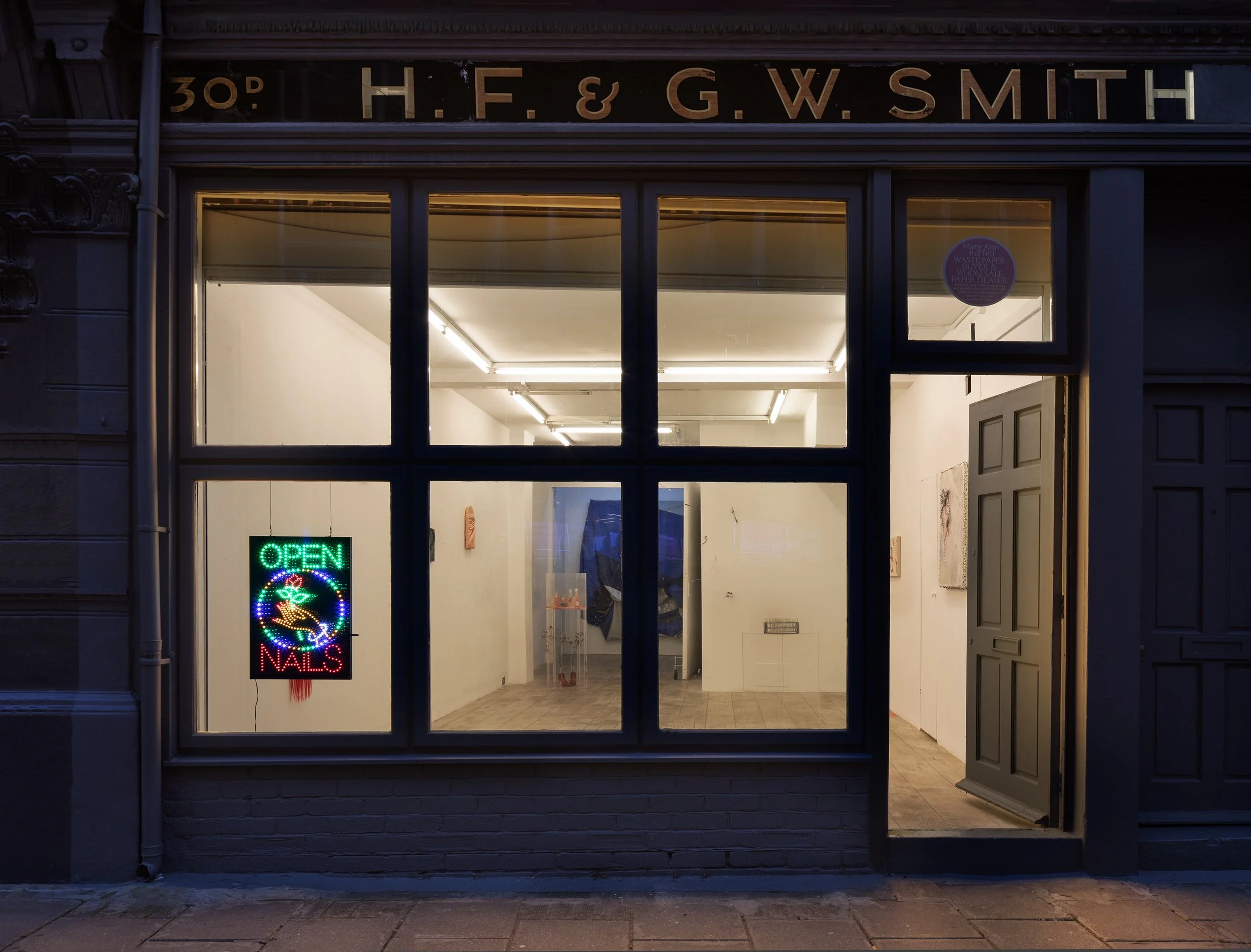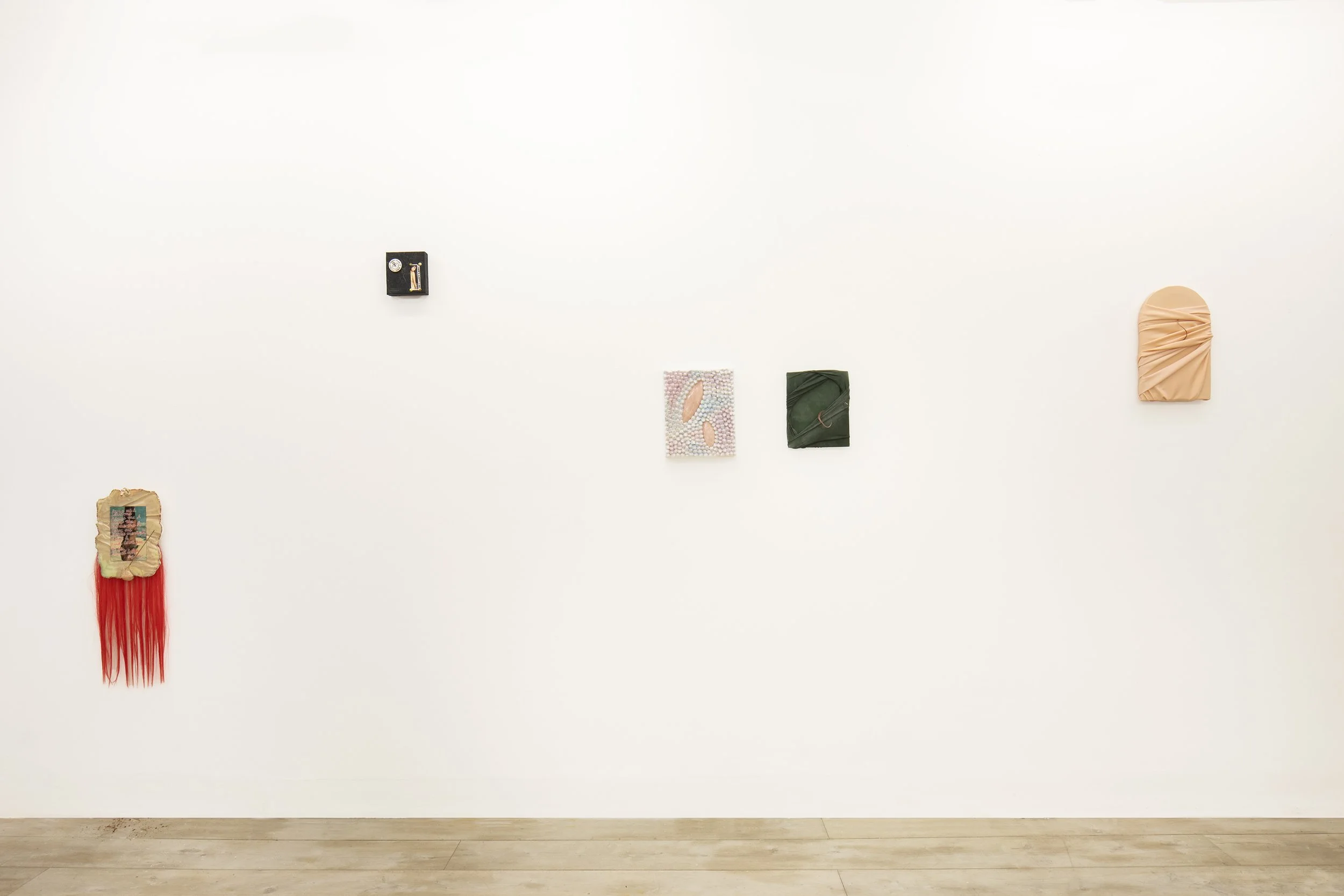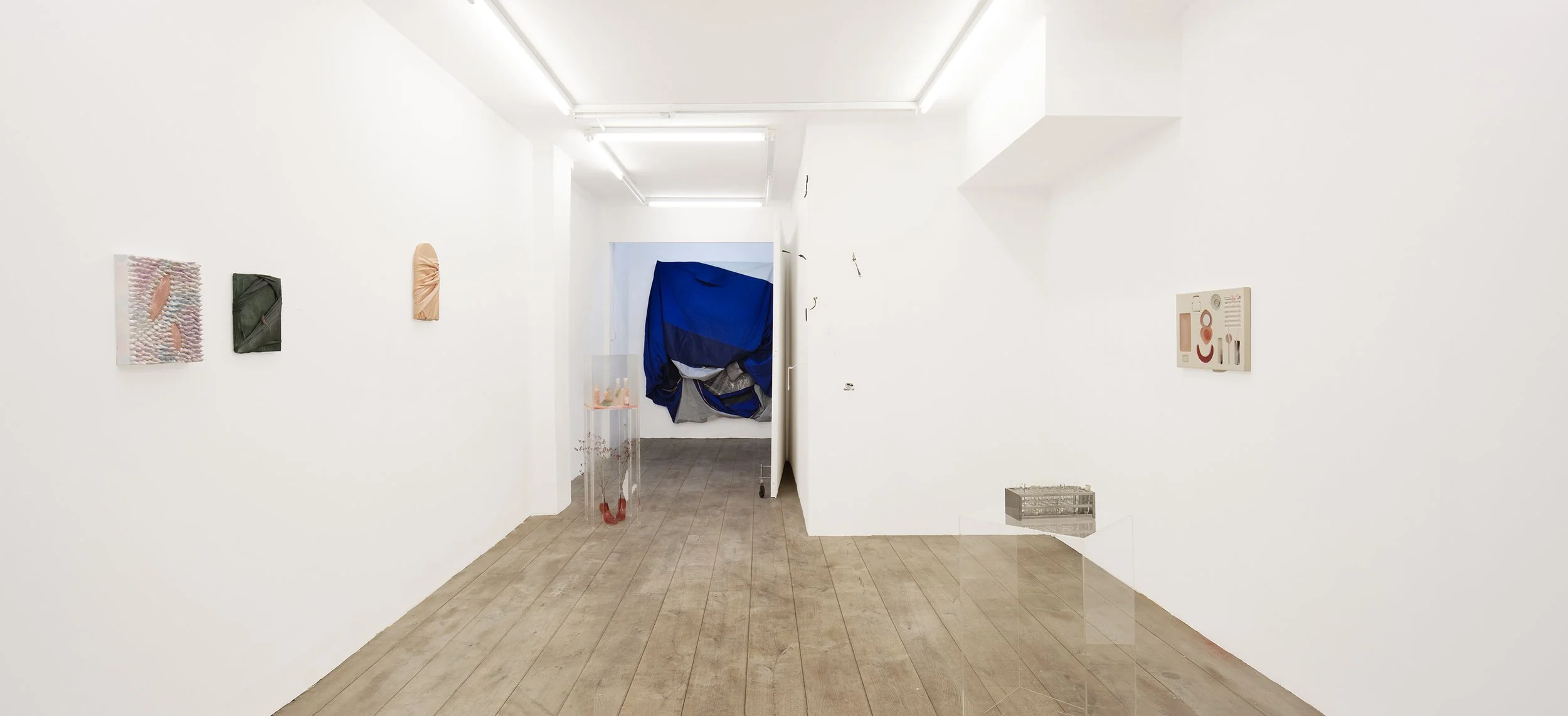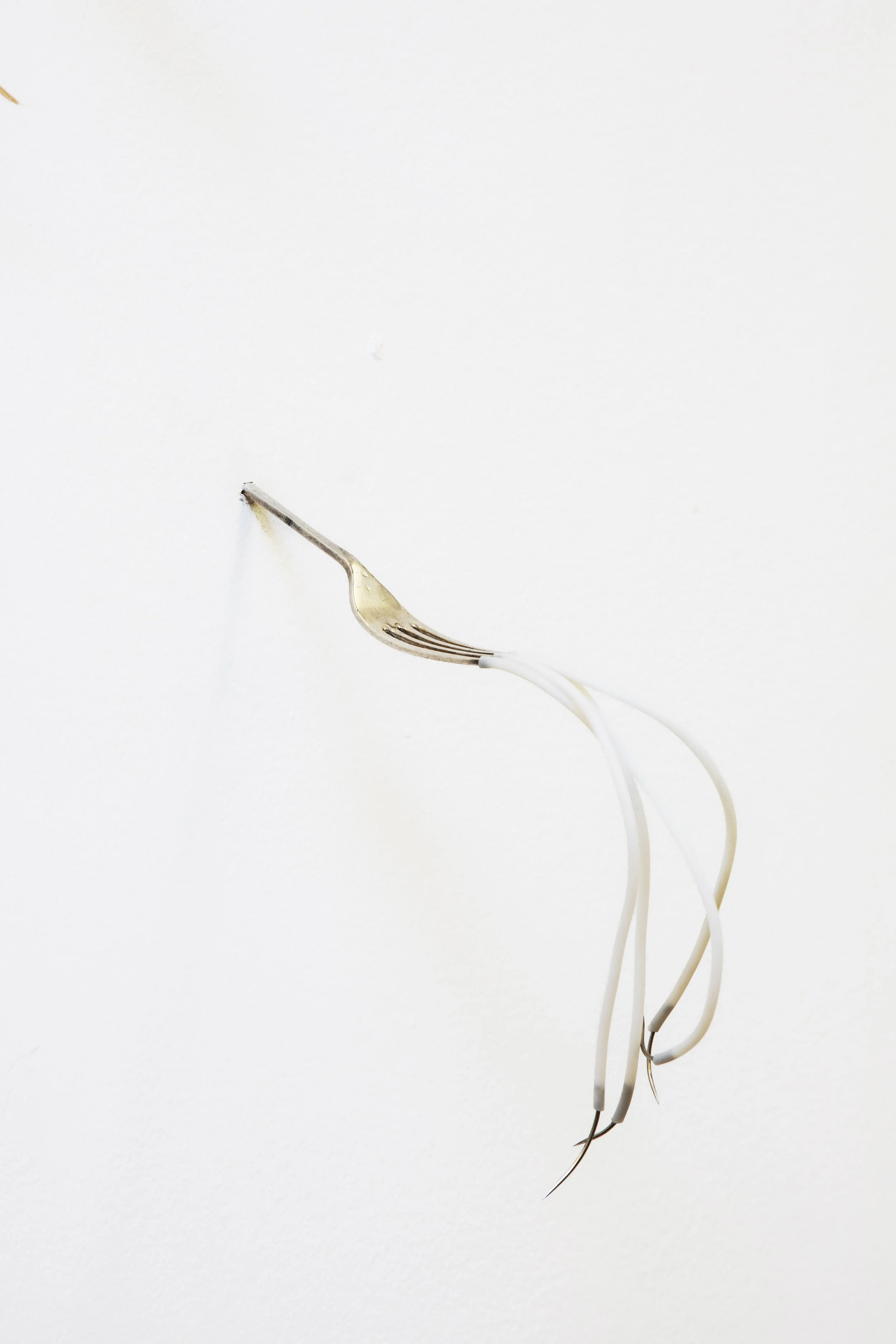
Treatment Menu
Words By: Carolina Fernandez
Images Courtesy: @mmmaqa_studio
There is hardly any activity, any enterprise, which is started with such tremendous hopes and expectations, and yet, which fails so regularly, as love - Eric Fromm
In contemporary capitalism, every need finds its market. From the logic of commodified healing, Naz Balkaya’s Break-up Kit imagines the aftermath of love as a curated delivery service for the newly single. This work gathers objects against a sterile white background, and in their arrangement, I make out the shape of a face. One mismatched eye is a miniature toy bear, although the comfort it might offer seems correspondingly small. The other eye is a more ambiguous object that Balkaya calls “the clock,” which, she explains, takes time off an ex’s life, “a month for every month you were together!”
A blush-pink nose appears in the shape of an open make-up compact that is unsettlingly flesh-like, while the face’s bright red smile is a dildo, “curved from so much use”. Beyond this composite face, other objects extend this uncanny, intimate portrait. Sitting between sincerity and satire, Breakup Kit offers both the often hollow solace of consumer culture and a wry acknowledgment of its absurdity.
Born from Breakup Kit, the exhibition Treatment Menu sees co-curators Naz Balkaya and Gigi Surel extend an inquiry into the spaces and rituals that structure experiences of love and loss. Taking up Eric Fromm’s idea that love is an art, a verb, requiring knowledge and effort, the exhibition traces how intimacy is practiced and negotiated in contemporary life.
In a stand-out piece, Natalia Janula engages with the psychological theory of attachment that is circulated widely in online relationship discourse (particularly aimed at women), in her installation Attachment Styles. Cutlery sprouts from the corner of two walls, or in some cases gives the illusion of having been thrown and stuck there giving physical form to the hidden currents that tether people to one another, where closeness and strain are never far apart. The prongs of a fork are extended with PVC tubes ending in metal “nails”, suggesting gestures of reaching infused with sharpness. A knife protrudes from the wall, pinning a lock of hair in place; its blade engraved with the ambiguous phrase DON’T BE SILLY the light-hearted reassurance to an overthinking partner? or, controlling admonition? Nearby, a spoon bends into a crouching, anthropomorphic figure. Fake eyelashes are glued to its “head” (upon which the word COSMOS is engraved) and a curtain of thin string spills from its edge like a waterfall. The overall scene is one of strange beauty. A kind of wild domesticity that holds intimacy poised on the knife-edge between tenderness and threat.
Shifting the focus to the online relationship content geared towards men, Ella Fleck offers commentary born out of months of research immersed in a discord chat devoted to pheromones, pickup techniques, and other pseudo-scientific rites of attraction. Part sculpture, part sensory experience, Diffuser translates the toxic logic of “the manosphere” into glass test tubes containing scents made of oxycontin, rose water, and holy water. Thus, Fleck exposed a culture obsessed with regulating, even manufacturing, desire.
A homage to culture, family and the Vietnamese diaspora, Hoa Dung Clerget’s neon sculpture in the outside-facing window of the gallery, a sign for an open nail salon provides a lens in which to interpret beauty practises as rehearsals for the act of being loved. Here, the ritual of manicures, hair treatments, or other cosmetic acts are more than self-maintenance; it’s a space where people expose themselves, trust others with their bodies and appearance, and engage in repeated gestures of care and attention that echo intimacy.
Julia Thompson likewise centres the relationship between beauty and love, but in her sculpture Thirst for Care, a sense of yearning is made palpable. A transparent glass structure, evoking a dressing table, holds vials of beauty products sculpted from soap and suspended in a sticky, viscous mixture; their constellation of colours evoking a magical, otherworldly atmosphere. Beneath the table, glass shoes are coloured a deep red by a strange concoction of resin, vodka, and dish soap, out of which dried lavender stems extend like legs in a confused dream. This fairy-tale quality suggests a love which is enchanting yet elusive. A sweet, tantalising fiction that mirrors the gap between effort and fulfilment.
Harry Whitelock’s tent, draped to resemble an abstract painting of colour and shape, seems to initially resist easy interpretation or obvious thematic link. While this work faintly conjures notions of a countryside holiday and pastoral idyllic, having grown up in London where this exhibition is shown the work instead brings to mind the precarious shelters of the unhoused that line the streets of this city. In this context, Moving Principle II reminds us to recognise that the human need for intimacy cannot exist without shelter or safety. Under contemporary capitalism, even the most basic conditions for care and connection are unevenly distributed.
Paula Parole’s pieces, incorporating the motifs of artificial hair and fake eyelashes, reflect on girlhood and the relational labour of break-ups whether as acts of friendship or self-improvement. Eve Dixon examines how gendered and queer forms of looking shape desire and the performance of sexuality. Together, these works underscore the exhibition’s central concern: love isn’t merely a feeling, but a practice learned, repeated, and negotiated within social and material conditions.
DON’T BE SILLY
Treatment Menu is a collaborative exhibition between Teaspoon Projects and Display Fever, bringing together artists and curators in a shared inquiry into the labour, risk, and renewal that love demands. The exhibition takes its cue from thinkers like Erich Fromm and bell hooks, who describe love not as a passive emotion but as an art form — a verb rather than a noun. In the midst of a post-capitalist culture obsessed with productivity, aesthetics, and possession, Treatment Menu asks what it means to love with intention and courage. As philosopher Byung-Chul Han observes, eros has been drained of transcendence under global capitalism, leaving us to seek connection through surfaces and screens. This exhibition reclaims love as an act of resistance — a practice of care, honesty, and persistence that insists on depth in an age of simulation.
Treatment Menu transforms the exhibition space into an experimental beauty salon — a site of ritual, touch, and transformation where art and care converge. Each artwork becomes a ‘treatment’, a gesture toward healing, curiosity, or renewal. Through this shared curatorial framework, the two platforms extend their ongoing dialogue about how artistic collaboration can itself be an act of love — one that balances vulnerability with trust, and structure with improvisation.
Exhibiting artists:
Eva Dixon | Ella Fleck | Hoa Dung Clerget | Natalia Janula | Paula Parole | Julia Thompson | Harry Whitelock
Co-Curators: Naz Balkaya & Gigi Surel
6-12 November 2025
30D Great Sutton Street
teaspoonprojects.com/treatmentmenu








